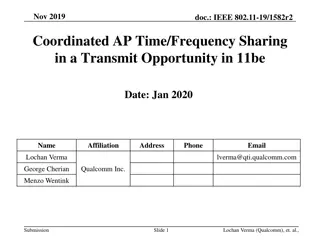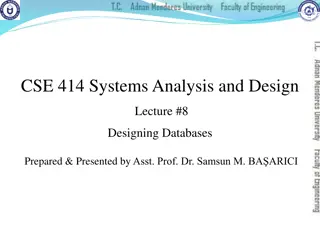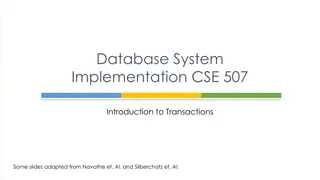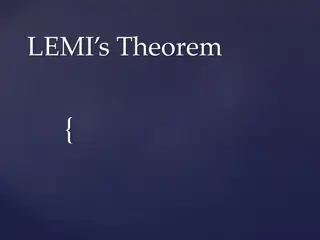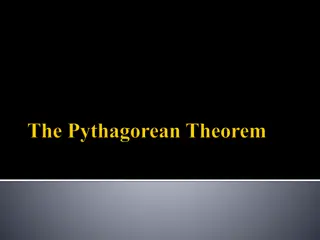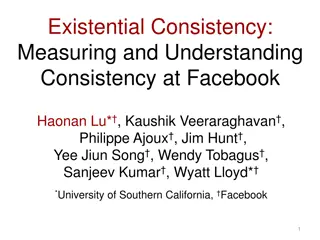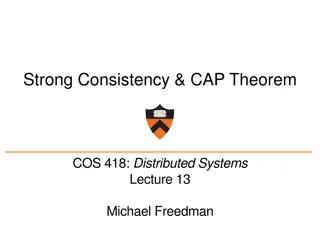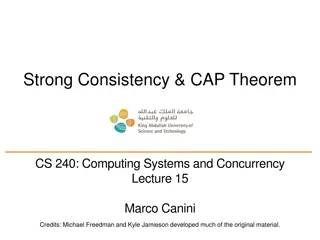The CAP Theorem and Database Consistency
Exploring the CAP Theorem introduced by Eric Brewer, the concept of Basic ACID semantics in databases, the importance of consistency, and examples elucidating atomic writes and sequential consistency in multi-process execution.
Download Presentation

Please find below an Image/Link to download the presentation.
The content on the website is provided AS IS for your information and personal use only. It may not be sold, licensed, or shared on other websites without obtaining consent from the author.If you encounter any issues during the download, it is possible that the publisher has removed the file from their server.
You are allowed to download the files provided on this website for personal or commercial use, subject to the condition that they are used lawfully. All files are the property of their respective owners.
The content on the website is provided AS IS for your information and personal use only. It may not be sold, licensed, or shared on other websites without obtaining consent from the author.
E N D
Presentation Transcript
The CAP Theorem Prof. Smruti R. Sarangi IIT Delhi 1
Basic Idea of the CAP Theorem At the PODC conference in 2000, Eric Brewer made the following conjecture We cannot design a protocol (web service) that simultaneously guarantees Consistency Availability Partition Tolerance 2
How do we understand them? Basic ACID semantics of databases Background Atomicity Operations either fully complete (commit) or fail in entirety Consistency The result of any execution is consistent. There are different definitions for the word ``consistent . Need to discuss Isolated Uncommitted transactions are isolated from each other (cannot see each others updates) Durable Once committed, a transaction s changes are permanent Distributed system services need a different model 3
Let us discuss consistency The dictionary meaning is that the execution s outcomes should satisfy some intuitive notion of correctness All operations appear to take place instantaneously. No intermediate state is ever visible. Atomicity Example Terminology Meaning P1 P2 Wx1 Set x = 1 Wx1 Wy1 Rx1 Read x = 1 Ry1 Rx1 P1, P2 Processes P1 and P2 x,y Global variables (initialized to 0) 4
Why does this example have atomic writes? P1 P2 Wx1 Wy1 Ry1 Rx1 We can lay the operations out in a sequence Rx1 Ry1 Wx1 Wy1 This sequence is legal Every read fetches the value of the latest write This is a sequence with atomic events (operations) that is also legal What else ??? 5
Sequential Consistency (SC) Equivalent global order P1 P2 Rx1 Ry1 Wx1 Wy1 Wx1 Wy1 Ry1 Rx1 Note the order of operations within each thread They have the same relative order in the equivalent global order Sequential consistency We can reduce a parallel multi-process execution to a sequential execution, where each operation is atomic, the sequence is legal, and the intra-thread (program) order is respected. The operations are basically interleaved to get the equivalent global order. 6
Can we have a non-atomic execution? P1 P2 P3 Wx1 Rx1 Ry1 Rx0 Wy1 If the program order is respected, we expect P3 to read (x=1) However, it reads (x=0) This means that the write to x (Wx1) is not atomic An intermediate state is visible 7
What is the problem with sequential consistency (SC)? Equivalent global order P1 P2 Rx1 Ry1 Wx1 Wy1 1. Wx1 3. Wy1 2. Ry1 4. Rx1 We only talk about relative orders. What if the real time order is like this: (1) (2) (3) (4) We should have seen the following outcome P1 P2 1. Wx1 3. Wy1 2. Ry0 4. Rx1 8
SC vs Linearizability SC is fine as a theoretical model (preserves relative orders, read-write relationships, and atomicity) However, can we ignore real-time constraints? operation Additional constraints in Linearizability start end Every operation takes effect instantaneously at some point of time between its start and finish. If operation B starts after operation A ends, then in the equivalent global sequential order, B appears after A No such requirement in SC 9
Other Types of Consistency Causal consistency Causally related writes (ordered by read-write and program order relationships) have to be seen in the same order by all processes Writes without causal relationships can be seen in any order Continuous consistency We maintain different replicas of variable x The replicas are loosely synchronized While reading a replica, we may get an inaccurate value (stale value) The error is bounded 10
Client-Centric Models Data center containing many servers Monotonic reads If a certain value for a variable was read, subsequent reads by the same process (possibly connected to a different server) yield the same (or a more recent result). Otherwise, we may find new emails while connecting to one server, and later when we connect to another server, we may find the mails missing Monotonic writes Write operations by the same process happen in order. Otherwise, the user s tweets will be read in a different order (2/2 first and 1/2 later) 11
Client-Centric Models II Read your Writes If a write operation is done on a process on item x, any subsequent read operation by the same process will see the same write (or something newer) Otherwise, a process will not be able to see its own updates Writes follow Reads A write operation that overwrites a variable will overwrite (fully or partially) the version that was read. See reactions to tweets, only after the original tweet has been read 12
Read and Write Quorums A write is typically sent to a quorum (multiple servers) Write quorum: NW servers ??>? We typically read from a read quorum (NR servers) and choose the most recent value To guarantee that the most recent value is read: ??+ ??> ? 2 (the write reaches a majority of servers) 13
What is the final word on consistency, then? Sequential consistency or other similar variants Atomicity 14
Availability and Partition Tolerance Availability Every request received by a correct node must result in a response. Requests must terminate. Partition tolerance A partition means that all messages sent from one partition to nodes in the other partition are lost. 15
Asynchronous Network Model Theorem We cannot guarantee both availability and atomic consistency for a read/write object in an asynchronous setting where messages can be lost. Proof Assume the network is divided into disjoint non-empty sets: G1 and G2 All messages between G1 and G2 are lost If a write occurs in G1 and later there is a read in G2, a stale value will be returned (atomicity violation ) Note, a node in G2 is bound to return a value by the availability requirement. 16
Asynchronous Network Model Corrollary We cannot guarantee both availability and atomic consistency for a read/write object in an asynchronous setting where no messages are lost. Proof Same argument as FLP: A node does not know if a message is lost or the sender is just slow. Another argument: Assume the earlier case where messages can be lost. Don t lose them, just keep them in cold storage. At some point, we will see a non-atomic execution (will happen for some example). At that point, release all the messages in the cold storage. Now, no messages are lost, yet the execution is non-atomic. 17
Guarantee two out of three Atomic and partition tolerant Don t return responses of partitions that are unreachable from a central node The central node maintains up-to-date state Atomic and available A centralized node for a single partition solves the problem Since we are not partition tolerant, unreachable partitions can be ignored Available and partition tolerant Provide stale values 18
Partially Synchronous Model Clocks are loosely synchronized (bounded clock skew) All network messages are either delivered within tmsg time units or are lost Theorem We still cannot guarantee availability, atomicity and partition tolerance. Proof Same approach as before: divide the network into two disjoint partitions -- G1 and G2 A read happens in one component after a write happens in the other Atomicity is still violated: there is no way for a write to go from G1 G2 19
Partially Synchronous Model (no messages lost) If no messages are lost, then there is a way out. Use a centralized scheme (a single central server that maintains state and answers queries) Assume a read/write object Unlike the asynchronous case, here we can detect message losses Just wait for (2tmsg + tproc (processing time) units of time If all messages are delivered, and availability is guaranteed, a response will come Otherwise, there is a message loss, and the best-known value (stale ???) could be returned 20
Conclusions and Extensions The CAP theorem limits what can be done in a distributed system. It has been extended in 2010 PACELC Theorem If the network is partitioned (P), a tradeoff exists between availability (A) and consistency (C) Else (E) Without partitions, we need to choose between latency (L) and consistency (C) 21
References Gilbert, Seth, and Nancy Lynch. "Brewer's conjecture and the feasibility of consistent, available, partition-tolerant web services." Acm Sigact News 33.2 (2002): 51-59. Golab, Wojciech. "Proving PACELC" ACM SIGACT News 49.1 (2018): 73-81. 22





